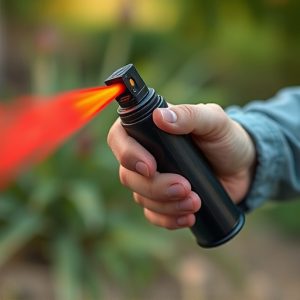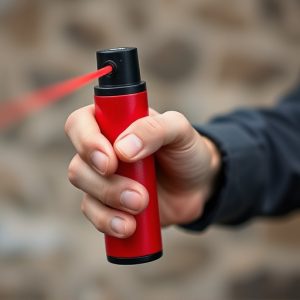Tactical Reloading Pepper Spray Canisters: Science, Safety & Legal Guide
Tactical Reloading Pepper Spray Canisters are specialized tools for law enforcement and security, cr…….
Tactical Reloading Pepper Spray Canisters are specialized tools for law enforcement and security, crucial for riot control and self-defense. Featuring swift deployment, durable design, and precise metering, they use capsaicin to cause temporary irritation without lethal harm. With various types like OC and CS gas sprays, each tailored for specific needs, their effective use requires extensive training on safety protocols, technique, range, wind dynamics, and timing. Strict regulations govern their usage, emphasizing ethical deployment while balancing public safety and individual rights.
“Uncover the power of tactical reloading pepper spray canisters—essential tools in riot control and law enforcement. This comprehensive guide explores the intricate world of these devices, from their scientific composition to practical applications. Learn about the science behind inflammatory sprays, discover various types suitable for different scenarios, and understand the critical importance of safety measures and training.
Delve into legal considerations and ethical use cases, ensuring responsible handling. Whether you’re a professional or interested in personal protection, this article offers an authoritative overview of tactical pepper spray canisters.”
- Understanding Tactical Pepper Spray Canisters: A Comprehensive Overview
- The Science Behind Riot Control Inflammatory Sprays
- Types and Applications: When to Use These Devices
- Safety Measures and Training: Responsible Handling Techniques
- Legal Considerations and Ethical Use in Law Enforcement
Understanding Tactical Pepper Spray Canisters: A Comprehensive Overview
Tactical pepper spray canisters, designed for law enforcement and security personnel, are specialized tools that play a crucial role in riot control and self-defense scenarios. These canisters are more than just a simple pepper spray; they are strategically engineered devices with advanced features to ensure effectiveness and user safety during high-pressure situations. The key aspect lies in their tactical reloading mechanism, allowing for swift and efficient deployment when every second counts.
These canisters are equipped with powerful, yet non-lethal, agents that temporarily disable individuals by causing severe irritation and discomfort to the eyes, respiratory system, and skin. The tactical design includes features like quick-release triggers, durable construction to withstand harsh conditions, and precise metering systems for controlled dispensing of the agent. With proper training, these canisters enable officers to effectively manage crowd control, disrupt violent gatherings, and protect both civilians and themselves in diverse, potentially dangerous environments.
The Science Behind Riot Control Inflammatory Sprays
Riot control inflammatory sprays, also known as pepper spray canisters, have evolved from simple irritants to sophisticated tactical tools. The science behind these devices revolves around the use of capsaicin, the active ingredient derived from chili peppers. When deployed, the spray creates a chemical reaction with the eyes and respiratory system, causing temporary but intense irritation. This disruption in balance leads to the rapid onset of symptoms like tears, coughing, difficulty breathing, and pain—all aimed at de-escalating and controlling riotous situations.
Tactical reloading pepper spray canisters are designed for efficient deployment in high-pressure environments. They offer quick activation mechanisms, ensuring law enforcement officers and security personnel can respond swiftly to threats. The modern formulations of these sprays consider factors like range, duration of effectiveness, and environmental impact, making them safer yet more powerful tools. With continuous advancements, these canisters play a pivotal role in riot control by providing a non-lethal but highly effective means of managing chaotic situations.
Types and Applications: When to Use These Devices
Riot control inflammatory spray canisters, also known as pepper spray or tactical reloading pepper spray canisters, come in various types designed for specific applications and scenarios. These devices are a crucial tool for law enforcement agencies, security personnel, and individuals seeking protection in high-risk environments. One common type is the oleoresin capsicum (OC) spray, which is highly effective in incapacitating subjects temporarily due to its irritant properties derived from chili peppers. Another variant is the CS gas spray, a powerful agent that causes tears, coughing, and temporary blindness, making it ideal for crowd control during riots or large gatherings.
The choice of canister depends on the intended use. For tactical situations requiring rapid deployment and maximum impact, quick-release canisters are preferred. These are often used by riot police to disrupt and disperse crowds. In contrast, personal defense devices are designed for individual use, featuring smaller, more compact canisters with precise spray patterns for targeted protection. These devices are popular among civilians seeking self-defense against potential threats in public spaces or while traveling. Understanding the different types and their applications ensures effective utilization of tactical reloading pepper spray canisters in various settings.
Safety Measures and Training: Responsible Handling Techniques
In the realm of riot control, tactical reloading pepper spray canisters are potent tools, but they require strict safety measures and comprehensive training for responsible handling. Law enforcement agencies and security personnel must undergo rigorous instruction to ensure they can effectively deploy these canisters while minimizing risks to themselves, bystanders, and property.
Training programs emphasize proper technique, including understanding the canister’s range, wind dynamics, and timing. Officers learn to aim accurately, allowing them to target specific individuals without affecting others nearby. Regular practice sessions with tactical reloading pepper spray canisters help maintain proficiency, ensuring that in high-pressure situations, officers can respond swiftly and effectively, preserving public safety and order.
Legal Considerations and Ethical Use in Law Enforcement
In many jurisdictions, riot control inflammatory spray canisters are governed by strict regulations due to their potent nature and potential for misuse. Law enforcement agencies must adhere to legal considerations when employing these tools, ensuring they are used ethically and proportionately. The use of pepper spray or tactical reloading pepper spray canisters is often allowed as a less-lethal option during crowd control situations, but officers must be trained to respect individual rights and avoid excessive force.
Ethical use involves considering the risk versus benefit ratio, especially in scenarios where peaceful protests turn violent. While these canisters can help restore order, law enforcement must also be mindful of bystander safety and ensure that the force used is necessary to de-escalate a situation without causing undue harm or violating civil liberties. Proper training, equipment maintenance, and ongoing discussions about tactical reloading pepper spray usage are crucial steps in upholding legal and ethical standards during public disturbances.
Tactical reloading pepper spray canisters are powerful tools designed for law enforcement and self-defense, offering a crucial layer of protection. By understanding their science, applications, and responsible handling, users can ensure their effectiveness while navigating legal considerations. This comprehensive guide highlights the importance of training and ethical use, enabling individuals to make informed decisions in high-pressure situations.


